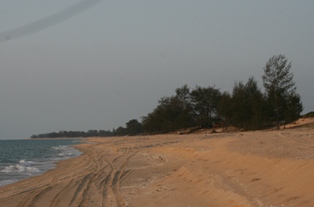
Abel Janszoon Tasman was a Dutch seafarer and explorer, best known for his voyages of 1642 and 1644 in the service of the Dutch East India Company (VOC).

The maritime European exploration of Australia consisted of several waves of European seafarers who sailed the edges of the Australian continent. Dutch navigators were the first Europeans known to have explored and mapped the Australian coastline. The first documented encounter was that of Dutch navigator Willem Janszoon, in 1606. Dutch seafarers also visited the west and north coasts of the continent, as did French explorers.

Exmouth is a town on the tip of the North West Cape and on Exmouth Gulf in Western Australia, 1,124 kilometres (698 mi) north of the state capital Perth and 2,060 kilometres (1,280 mi) southwest of Darwin.
Willem Janszoon, sometimes abbreviated to Willem Jansz., was a Dutch navigator and colonial governor. Janszoon served in the Dutch East Indies in the periods 1603–1611 and 1612–1616, including as governor of Fort Henricus on the island of Solor. During his voyage of 1605–1606, he became the first European known to have seen and landed on the coast of Australia.

Cape Leeuwin is the most south-westerly mainland point of the Australian continent, in the state of Western Australia.
The Eendracht was an early 17th century Dutch wooden-hulled 700 tonne East Indiaman, launched in 1615 in the service of the Dutch East India Company (VOC). Its Dutch name means "concord", "unity" or "union", and was a common name given to Dutch ships of the period, from the motto of the Republic: Concordia res parvae crescunt . The ship was captained by Dirk Hartog when he made the second recorded landfall by a European on Australian soil, in 1616.

Onslow is a coastal town in the Pilbara region of Western Australia, 1,386 kilometres (861 mi) north of Perth. It has a population of 848 people and is located within the Shire of Ashburton local government area.

The Pennefather River is a river located on the western Cape York Peninsula in Far North Queensland, Australia.

Eendrachtsland or Eendraghtsland is an obsolete geographical name for an area centred on the Gascoyne region of Western Australia. Between 1616 and 1644, during the European Age of Exploration, Eendraghtsland was also a name for the entire Australian mainland. From 1644, it and the surrounding areas were known as New Holland.
Lenaert Jacobszoon was a captain of the Dutch East India Company who, on 31 July 1618 in the vessel Mauritius, sighted North West Cape in the north-west of Western Australia mistakenly believing it to be a large island. He also named the Willems River and the Jocob Remmessens River in the same voyage.

Tryal Rocks, sometimes spelled Trial Rocks or Tryall Rocks, formerly known as Ritchie's Reef or Greyhound's Shoal, is a reef of rock located in the Indian Ocean off the northwest coast of Australia, 14 kilometres (8.7 mi) northwest of the outer edge of the Montebello Islands group. It is named for the Tryall, the first known shipwreck in Australian waters, which sank after striking the then-uncharted rocks in 1622. Described as "the theme and dread of every voyager to the eastern islands", their location was sought for over three centuries before finally being determined in 1969.

Willem Janszoon captained the first recorded European landing on the Australian continent in 1606, sailing from Bantam, Java, in the Duyfken. As an employee of the Dutch East India Company, Janszoon had been instructed to explore the coast of New Guinea in search of economic opportunities. He had originally arrived in the Dutch East Indies from the Netherlands in 1598, and became an officer of the VOC on its establishment in 1602.

Hessel Gerritsz was a Dutch engraver, cartographer, and publisher. He was one of the notable figures in the Golden Age of Netherlandish cartography. Despite strong competition, he is considered by some "unquestionably the chief Dutch cartographer of the 17th century".

Leeuwin, was a Dutch galleon that discovered and mapped some of the southwest corner of Australia in March 1622. It was captained by Jan Fransz and was the seventh European ship to sight the continent.

Caert van't Landt van d'Eendracht is a 1627 map by Hessel Gerritsz. One of the earliest maps of Australia, it shows what little was then known of the west coast, based on a number of voyages beginning with the 1616 voyage of Dirk Hartog, when he named Eendrachtsland after his ship.
Thirteen ships of the Dutch East India Company and its pre-companies have been named Amsterdam.
Joris Carolus was a Dutch cartographer and explorer who was employed by the Noordsche Compagnie and the Dutch East India Company.

The Mauritius was an early 17th century Dutch wooden-hulled sailing ship, documented as being in service to the Dutch East India Company between 1618 and 1622.

The Willem River or Willem's River was named during the voyage of the Dutch East India Company ship Mauritius in 1618, under the command of Supercargo Willem Janszoon and captained by Lenaert Jacobszoon, and is one of the few features named on a nautical chart made in 1627.


















